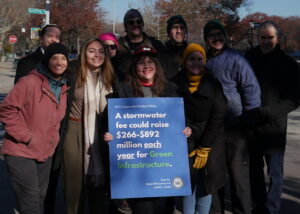By Oona Milliken | omilliken@queensledger.com
On Sept. 29th, 2023, heavy rainfall flooded the streets of New York City prompting Mayor Eric Adams and NY State Governor Kathy Hochul to declare a state of emergency. In Brooklyn, areas like Gowanus, Williamsburg and South Williamsburg were particularly hard hit with flood water falling more than eight inches in some parts of the city. Now, local Brooklyn politicians are attempting to prevent the next flood incident by proposing rainwater legislation to allow for a fee to fund more comprehensive water and run-off infrastructure.
At a press conference in front of McCarren Park, where flooding submerged cars in September, State Senator Emily Gallagher, alongside residents affected by the floods, as well as Councilmember Lincoln Restler and State Senator Kristen Gonzalez, introduced legislation that is expected to collect anywhere between $266 million to $892 million a year. In a press conference, Gallagher said the legislation is intended to raise money for the creation of green infrastructure in Williamsburg and Greenpoint.

Gallagher and press conference attendees at the event, held in area of Williamsburg that was hit hard by the flooding on September 29th. Photo credit: Oona Milliken
“You can imagine the terror as you watch the water rise. That’s what many of our neighbors here experienced with little warning from the city [on September 29th],” Gallagher said. “Green infrastructure is what we call the array of practices that use or mimic natural systems to manage stormwater runoff, rain gardens, infiltration basins, stormwater green streets, green roofs, permeable paving, the list goes on. But now take a look at this map of green infrastructure projects in New York City. There’s almost nothing in Greenpoint or Williamsburg.”
The legislation is a little bit “wonky” according to Senator Gallagher. She is not proposing an implementation of any type of fee but legislation that would allow the city of NYC Municipal Water Finance Authority to collect revenue from property owners in New York at their Finance Authority’s discretion. Right now, the Authority does not have the jurisdiction to add new fees.
According to John Paraskevopoulos, the Legislative Director for Gallagher’s office, the fee is meant to be implemented on those who own impervious surfaces such as concrete parking lots. Paraskevopoulos said that any additional revenue acquired by the Water Finance Authority would go to alleviate high water and sewer bills.
“It doesn’t mandate anything, but it creates a framework within which a stormwater fee could be implemented and authorizes the creation of one by any sewer authority in the state,” Paraskevopoulos said. “And also, if there’s any revenue left over, hopefully, it can help balance or make more equitable people’s existing sewer rates and water bills.”
Gallagher’s office is basing their legislation in part on a study on rainwater by New York’s independent budget office. The study modeled their findings off of rainwater fees in other large cities, Baltimore, Philadelphia, Seattle, and Washington, D.C. in order to create revenue predictions for New York City.
Brenda Suchilt, a horticulturist for Newtown Creek Alliance, an organization dedicated to restoring and revitalizing Newtown Creek, said that creating more greenspace to absorb excess rainwater can do more than just help prevent flooding.
“There’s a lot of value in green infrastructure aside from obviously diverting a lot of this local flooding from our combined sewage overflow,” Suchilt said during the press conference. “It has an encompassing benefit for the community. Aside from the safety side, there’s an encompassing value with green infrastructure, aside from beautifying these neighborhoods and creating habitat for local wildlife, it can also help with our urban heat island effect.”
Attendee of the press conference Kelly Marks, a Greenpoint resident, said she had to help her downstairs neighbors on Sept. 29th when a wall collapsed on them with their one-year-old in the apartment. Marks said she feared another dangerous flood and hoped that the new legislation would go towards preventing potential deaths due to excess rainwater.
“The water flooded five feet on the first floor. It came in through one of the windows. It was so powerful and came in so quickly that it knocked the wall that separates [the apartments],” Marks said. “Something has to be done, because my biggest fear, besides losing lovely neighbors, watching them lose belongings and feel afraid in their own homes, I’m so afraid someone is going to die if something isn’t done soon.”


